How to Maintain the Shine of Your Granite Countertops
Matt Greenlee • June 12, 2025
When someone walks into a kitchen with polished granite, it turns heads. There’s just something about that deep, reflective finish that says, “This space matters.” But if you’ve ever wondered how to keep that shine looking like day one, you’re not alone—and you’re not wrong to ask.
We’ve been fabricating and installing granite countertops
here in Prescott for 27 years. And one of the first things customers ask after install is, “How do I keep it looking this good?” Good news: it’s not hard. You just need to know a few key things.
It Starts with Cleanliness
We always say the best maintenance is a clean countertop. Daily wipe-downs go a long way—just a soft cloth and mild soap will do. Granite is tough, but grit and grime left sitting can start to dull that surface over time.
Think of it like this: your countertop is already polished to a mirror finish. The goal is to protect that polish—not redo it.
Understanding What "Shine" Really Means
That glossy look isn’t from a coating—it’s from the stone itself. When we polish granite, we’re using finer and finer abrasives (think of it like super high-grit sandpaper) to smooth the surface until there are no visible scratches. The fewer scratches, the more the light reflects—and that’s your shine.
If you drag something across that surface—especially metal or something gritty—you’re introducing scratches bigger than the ones already there. That’s how shine gets lost.
What to Watch Out For
Most of the time, folks aren’t ruining their counters with one big mistake. It’s the little things repeated over time. Here are a few habits to stay aware of:
- Avoid sliding pots, pans, and cast iron across your granite. These can carry abrasives from the stovetop or food that act like sandpaper.
- Don’t drop your grocery bags down if they’ve been sitting on the ground. Dirt stuck to the bottom of a bag is enough to dull the finish.
- Keep your countertops dry when possible. Water rings can collect dust and minerals that slowly build up if not wiped clean.
- Use trivets and cutting boards. Granite is strong, but the surface polish benefits from a little respect.
Regular Maintenance, Simplified
You don’t need fancy products or a complicated routine. If you follow these simple steps, your counters will keep their luster for years to come:
- Wipe up spills daily using a soft cloth and mild soap.
- Use a granite-specific cleaner weekly if you want to boost that shine.
- Avoid harsh chemicals or abrasive scrubbing pads.
- Consider resealing once a year (ask us if your granite needs it).
When the Shine Starts to Fade
Every stone surface has a lifespan, but the good news is: granite can always be brought back. If your countertop has dulled over time or taken some abuse, give us a call. We can often restore that shine with a little professional TLC.
We interpret a lot of that all the time. You might not need a full resurface—just a good clean and polish.
The Real Secret? Respect the Stone
Granite is a natural material, and part of its beauty is that it’s unique. It has movement, depth, and texture that’s unmatched—and it deserves care that honors that.
We always tell folks: treat your countertop like a centerpiece. Because in most homes, it is.
Still Have Questions?
Come see us. Bring a sketch. Bring a question. Heck, bring a picture of a spill you’re not sure how to clean. We’re here to help—whether you bought your countertop from us last week or ten years ago.
Designing Surfaces For Your Life
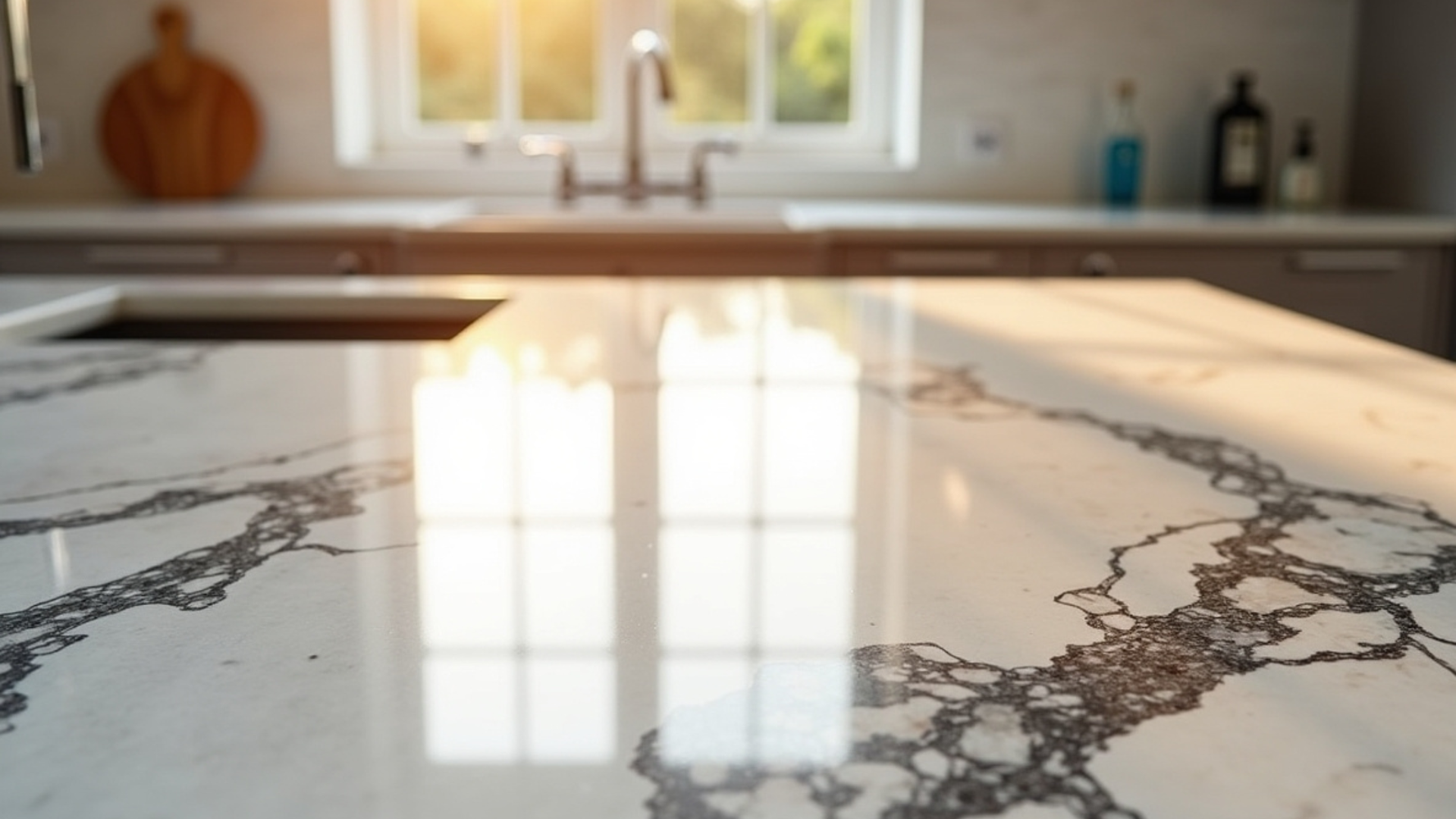
When people ask me about quartz, they’re almost always trying to make a choice that will hold up—not just physically, but stylistically. I hear things like, “I don’t want something that’s going to look dated in five years,” or, “Is this finish going to stick around?” After 27 years of working with homeowners, designers, and builders here in Prescott, I can tell you: Yes, you can choose smart. Quartz gives you a path to long-lasting style if you know what to look for. Trends come and go. But the right quartz countertop has a quiet confidence to it; something that stays in step with shifting color palettes without ever looking tired. And that’s what I want to walk you through. Why Quartz Holds Up So Well Over Time One thing I’ve seen over the years is that subtle patterns age far better than bold ones. In a lot of the trendy colors hitting the market, manufacturers lock onto whatever’s popular in the moment—strong veining, big splashes of color, high contrast. And while those look great for the season, they can become the avocado-green appliances of tomorrow. But quartz designs with softer patterns . . . those stay right in the flow of design trends. They blend with light gray tones, warm whites, creams, golds—colors that continue to show up year after year in cabinets, backsplashes, and flooring. That subtlety gives you freedom to redesign a bathroom or kitchen around your countertop without replacing it every time you update paint or hardware. The Colors and Patterns That Stand the Test of Time In the last few years, we’ve seen grays fade a bit while white backgrounds and very light gray bases continue to stay strong. If you want something with staying power, that’s where I’d start. And quartz with a soft combination of gray and gold veining tends to be even more flexible—you can match that to warm woods, modern whites, painted cabinets, or natural finishes. Bold designs are fun, but subtle patterns are what I recommend for long-term durability of style. Here’s what I consider “safe bets” when you’re thinking long term: Light, soft-patterned quartz Whites with gentle gold or gray veining Cream tones with low contrast Very light grays that don’t pull too blue Patterns that mimic natural stone without being overly dramatic Those are the materials that “stay in the moving trends,” as I like to say. They evolve with your space rather than limiting your choices down the road. What About Other Finishes—Are They Trendy or Timeless? People sometimes ask whether finishes themselves—polished, honed, leathered, suede—come and go. In my experience, those aren’t falling in or out of favor as much as folks think. Polished is still the most common, but satin, matte, or suede finishes have carved out a solid place. A few things to know: Matte or suede quartz finishes look great, but they do take a little more attention to keep clean. Because of the micro-texture, they tend to “grab onto” stains more easily. They come out, but they take a bit more care. Darker quartz in matte finishes can show hard water deposits and oils more easily than lighter ones. Hard water is white, so it’s more visible on darker colors. Polished finishes are the easiest to maintain and still the most popular for busy kitchens. If you love the look of a matte finish, choose a lighter color and you’ll have a much easier time day to day. Choosing Smart Means Choosing What Works for Your Life Quartz gives you options—timeless options—when you know what to look for. I’m always going to steer people toward materials that give them long-term value. You’re investing in something you’ll see and touch every day. You want it to feel good five, ten, twenty years down the line. If you want to talk through the subtle patterns, the durable finishes, and the quartz designs that really do stay in style, bring a sketch and come see us in our Prescott showroom . We’ll help you explore what feels right and fits your space for the long haul. Designing Surfaces For Your Life
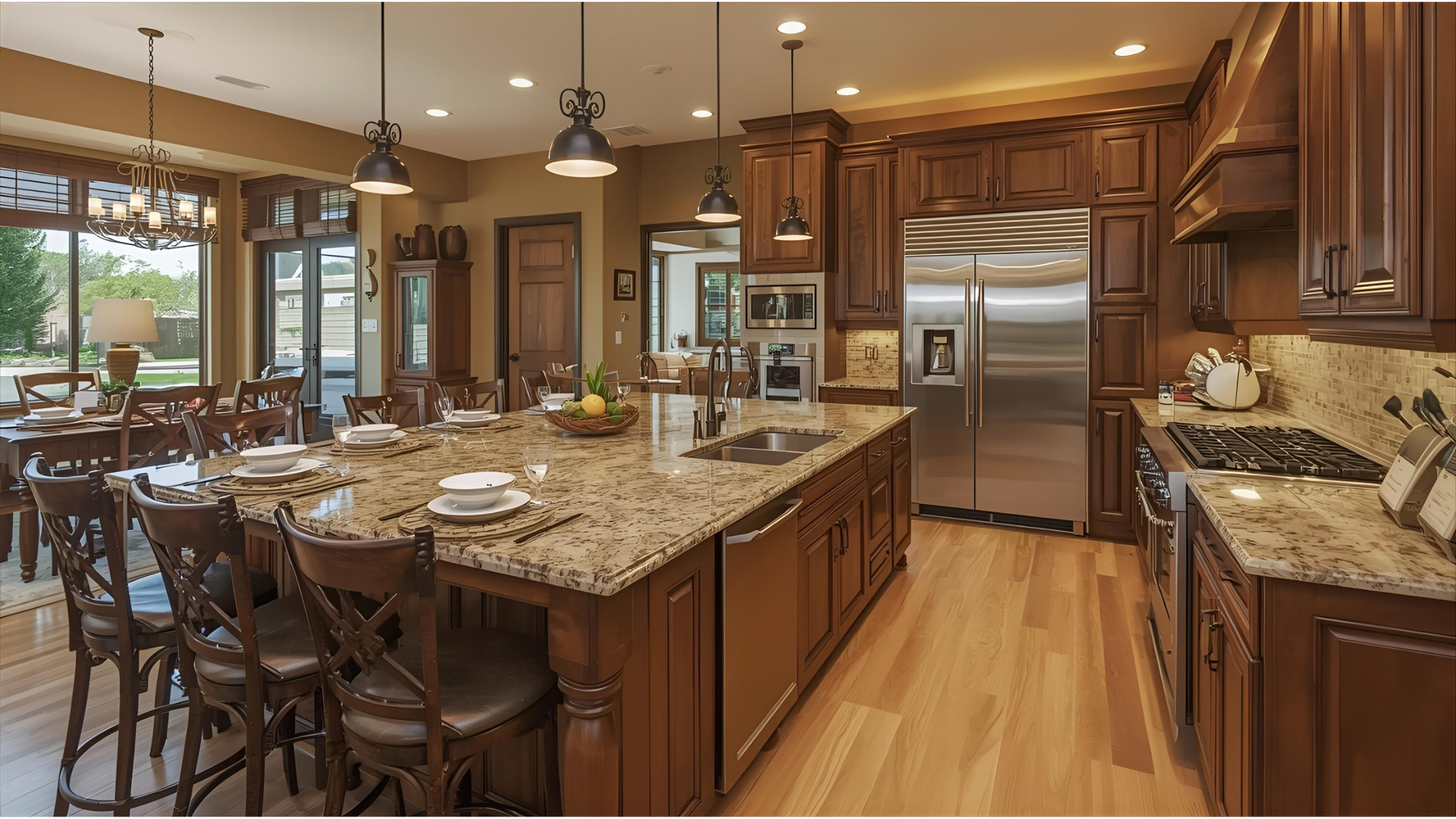
When people walk into our Prescott showroom and start talking flooring, one of the first questions that comes up is, “Can I put laminate in my kitchen or bathroom?” And the short answer is yes, you can—you just need to understand how today’s laminate is built and how to use it wisely in those moisture-heavy areas. I’ve been in this business a long time, and I’ve seen laminate evolve from something you’d avoid around water to a product that actually holds its own when it’s treated right. The newer materials are engineered with added oils in the wood, then pressure-treated with heat. That combination creates superior water resistance compared to the laminates we all grew up with. Still, like anything else in your home, it performs best when you give it a little support. Why Modern Laminate Handles Moisture Better Today’s laminate isn’t the same stuff people used twenty years ago. Manufacturers are using oils, pressure, and heat to help the core resist swelling. That means the occasional splash or spill isn’t the enemy it used to be. Now, if you pour water on it and walk away for hours, sure—you might see some damage. But in real-life living, where you’ve got a family coming and going and regular cleanups happening, it can hold up just fine. That’s why I tell people: laminate in kitchens and bathrooms isn’t something to be scared of. It just needs a few smart habits to stay in great shape. How to Protect Laminate in Kitchens and Bathrooms Moisture isn’t just about big spills. It’s the daily drips around your shower, the splash zone at the sink, and—let’s be honest—the mystery puddles that show up around the toilet. Here’s where planning makes a difference. I always recommend placing rugs in the high-moisture spots. That’s your first line of defense. Simple areas to protect with a small rug or mat: Right outside the shower In front of the bathroom sink Around the toilet In front of the kitchen sink In front of the stove (for cooking spills) These aren’t complicated solutions—they’re just practical. And they let laminate do what it’s designed to do without pushing it past its limits. Laminate in Kitchens: What to Expect Kitchens are high-traffic, high-function rooms. I’ve installed plenty of laminate in kitchens over the years, and what matters isn’t avoiding water altogether—it’s managing it. Putting a rug by the sink is an easy win, and I even like adding one in front of the stove. Not only does it help with spills, but it’s also more comfortable when you’re cooking. The good news is: regular use, daily cooking, wiping up splashes—these aren’t going to bother a modern laminate floor. Laminate in Bathrooms: Yes, It Works Bathrooms can feel trickier because there’s more standing water potential. But again, a little prevention goes a long way. Laminate is a perfectly good product for bathrooms as long as you place mats where they matter and don’t let puddles sit untouched for long stretches. I’ve seen families get years and years out of bathroom laminate by following these simple habits. It’s always about balancing beauty , durability , and lifestyle . If you love the look and feel of laminate, you don’t have to be afraid of using it in a bathroom. Final Thoughts: Make Your Home Work for You At the end of the day, laminate in wet zones comes down to smart choices and understanding how the material behaves. The newer laminates are built to resist moisture better than ever, and with just a little planning, they can be a durable, attractive option for your kitchen or bathroom. If you’re thinking about new surfaces—flooring, countertops, or anything in between—bring a sketch and come see us. We’ll walk you through the options that make sense for your home and your lifestyle. After 27 years in this business, we’ve “seen it all,” and we’re here to help you find what feels good. Designing Surfaces For Your Life
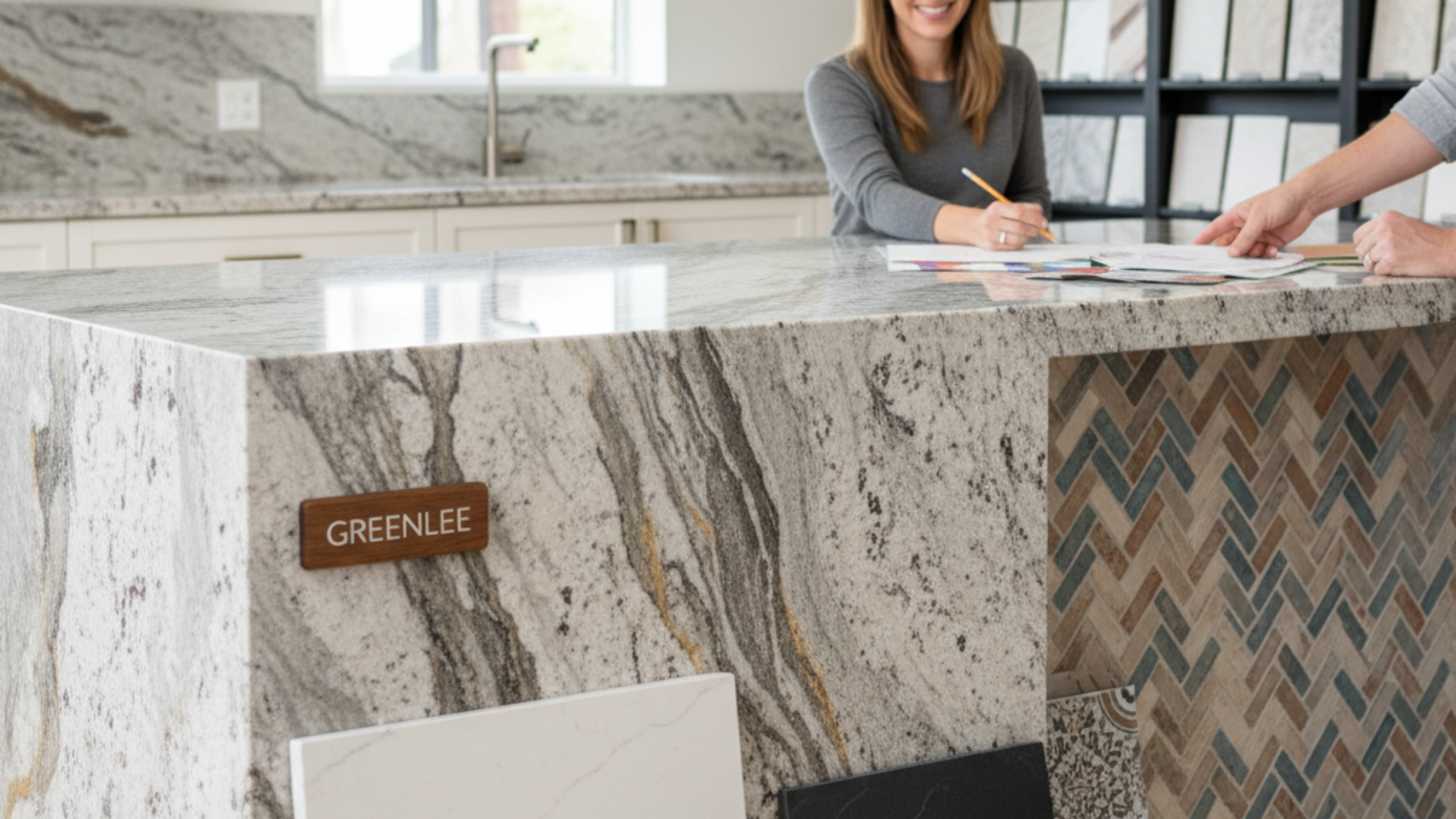
When you walk into a home that just feels right, where everything flows, the colors and textures speak to each other, and it all just fits, that’s not by accident. That’s the power of designer surfaces. Whether it's stone, tile, or flooring, the materials you choose do more than cover a countertop or a floor. They tell a story, your story. And when those materials are thoughtfully selected, they bring your custom home vision to life in a way that’s both personal and lasting. Here at Greenlee, that’s exactly what we help people do. It All Starts with Options (and Guidance) One of the things we’ve always focused on is giving people more options—especially when it comes to stone and tile. We know that can feel overwhelming at first. You walk into our showroom, and there’s a lot to take in. But that’s part of our process. We start with a conversation. We listen. We ask questions about your lifestyle, your space, your preferences. That little “interview” helps us understand what matters to you—what you like, what you don’t like, and what’s going to feel good in your home. From there, we help narrow it down and start guiding you toward selections that make sense for you. This isn’t about pushing a product. It’s about helping you create something meaningful with the right materials. Surfaces That Reflect Your Style Custom surfaces are one of the most impactful parts of a custom home. They’re where function meets form and where beauty meets durability. And they’re one of the best ways to reflect your personal style without saying a word. Whether you're drawn to the raw, natural movement of granite or the smooth consistency of quartz , whether you love bold tile backsplashes or subtle neutral tones, the surfaces you choose are going to define the tone of your space. We’ve seen homeowners light up when they find that one slab—the one with the veining that reminds them of driftwood, or the one with soft golds that tie their whole kitchen together. That’s when you know you’ve found the right surface. Why In-Showroom Matters You can browse pictures all day long, but there’s no substitute for seeing and touching materials in person. There’s something about walking the showroom and seeing firsthand how the light hits each slab, running your hand across the texture, feeling the weight and strength in the material. That’s why we do things the way we do. You’re not just ordering off a shelf. You’re choosing from curated inventory that we’ve hand-selected for quality, beauty, and variety. What Makes the Greenlee Experience Different We don’t believe in one-size-fits-all. When you come to Greenlee, you're getting: A deep inventory of natural and engineered materials you can view on-site Thoughtful guidance based on 27 years of experience In-house fabrication and installation (no hand-offs or outsourcing) Honest conversations about what will work best for your home and lifestyle A process that’s personal, not pushy There’s a reason we say: “Come see us.” Because once you do, you'll understand how different the experience can be when it's done right. Design That Lives With You We’re not just here to help you pick something pretty. We’re here to help you pick something that’s going to live with you, hold up to real life, and still make you feel good every time you walk in the room. That’s what design is really about, not trends, not hype, but choices that match your values, your routines, and your vision for your home. Bringing It All Together The materials you choose, the ones you cook on , gather around, walk across every day, they shape your home in ways you may not even realize. When they’re thoughtfully selected, when they’re fabricated with care, and when they’re installed the right way, they don’t just serve a purpose, they become part of the story you’re building in your space. So if you’re building or remodeling and want help finding the surfaces that truly reflect your custom vision, bring a sketch and come see us. We’ll help you find what makes you feel good. Designing Surfaces For Your Life Come see us.
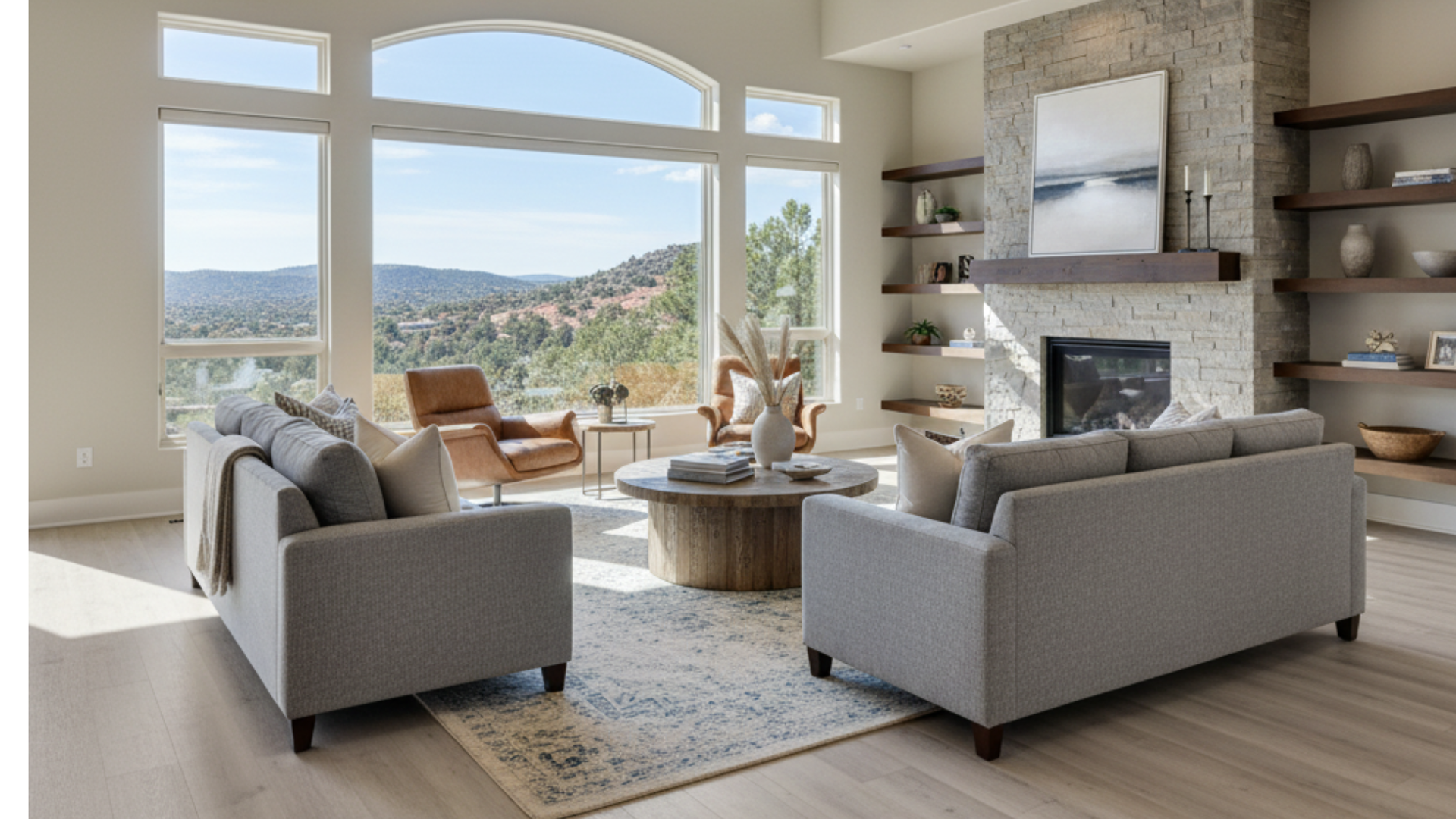
When it comes to choosing the right flooring for your home, you’ve got a lot of great options and a lot of noise to sort through. Two of the most common choices we see homeowners considering are laminate flooring and engineered hardwood. Both can look fantastic. Both can last a long time. But they perform differently, install differently, and, maybe most important to many homeowners, they come with very different price tags. We carry multiple lines of laminate here at Greenlee, but today I want to highlight Hawkins Bay , a product line we’ve added to our showroom for good reason: it’s durable, cost-effective, and built for real life. Let’s break it down. Cost Comparison: Laminate Is the Clear Winner Let’s just start with the big one—cost. Engineered hardwood simply costs more, both in materials and in installation. If you’re on a tighter budget or need to cover a large space without compromising durability, laminate is going to stretch your dollar a lot farther. That said, price isn’t everything. It depends on what your goals are. If you're after a natural wood floor with unique, one-of-a-kind boards, engineered hardwood may be worth the investment. But if you're looking for a more budget-friendly material that still looks great and holds up well, laminate has come a long way. Installation: Floating vs. Glued Down There’s also a big difference in how these floors go in. Here at Greenlee, we prefer to install engineered wood as a floating floor, especially over concrete. It gives the wood room to breathe and reduces the risk of delamination between the finish species and the plywood subcore. Some folks still glue it down, but in our experience, gluing engineered wood to concrete creates a lot more stress on the material. I’ve seen more delamination issues with glued-down installs than with floating ones. Laminate, on the other hand, was made to float. Most laminate products, including Hawkins Bay, feature a click-and-lock system. There's no glue involved, and the boards just snap together. It's faster to install, and you can put a lot down in a single day. Durability and Moisture Resistance: Laminate Has Come a Long Way I’ll be honest, I used to think laminate might go the way of the dinosaur once vinyl plank hit the scene. And for a while, it looked like that might happen. But Hawkins Bay and other newer laminates have totally changed the game. Laminate is still a wood-based product, but it's no longer the sawdust-and-glue mix it used to be. Hawkins Bay uses an oil-based bonding agent and applies high heat and compression to create a core that’s much more resistant to moisture than older versions. Now, that doesn’t mean you can flood your kitchen and forget about it. You still have to pay attention to moisture, especially from underneath the floor. But the top surface of today’s laminate is extremely durable, in some cases, more durable than engineered hardwood or even vinyl plank. Comparing Core Stability: Laminate vs. Vinyl Plank I’m going to veer off course for a second here because this is something we see a lot in the field. Many folks ask us about vinyl plank floors, and while they can look nice, they come with their own set of issues—especially when the subfloor isn't perfectly flat. Vinyl planks are thin, and the locking mechanisms are small. If there’s any deflection or unevenness in your subfloor, those planks will come apart, and we end up going back to glue them together just to hold them in place. Laminate, on the other hand, tends to be thicker and has a more robust locking system. It’s more forgiving on slightly uneven floors and holds together better over time. Aesthetics: Uniqueness vs. Consistency Here’s where engineered hardwood really shines—no two boards are exactly the same. The grain, the knots, even how the tree grew in wet or dry years... all of that shows up in the finished product. It’s what makes wood floors feel warm and alive. Laminate is a manufactured product, so yes—you’re going to see some pattern repeats. But that’s not always a bad thing. In a big open space, consistency can actually be a good thing, especially when you’re trying to match colors or textures across a room. Here’s a quick rundown of how they compare: Engineered Hardwood Higher cost Real wood surface Unique grain in every board Susceptible to dents and scratches Can be refinished (depending on thickness) Laminate (Hawkins Bay) Lower cost Manufactured appearance with consistent patterns Extremely durable surface Moisture-resistant core Click-and-lock installation What We're Seeing in the Field Over the past few years, we’ve seen a steady shift back toward laminate especially the newer, high-performance options like Hawkins Bay. Many flooring professionals we talk to are choosing laminate over vinyl plank because of fewer callbacks, fewer failures, and better long-term performance. The advances in core technology and surface durability have really earned laminate its place back in the conversation. And for homeowners who want something durable, attractive, and budget-friendly, it’s becoming an easy choice. Choose What Makes You Feel Good The right floor isn’t just about price or performance, it’s about how it fits into your life. If you’ve got kids and dogs and don’t want to worry about every little scuff, Hawkins Bay laminate might be the perfect fit. If you love the feel of natural wood and want something truly one-of-a-kind, engineered hardwood is hard to beat. Whatever you’re leaning toward, come walk the showroom . We’ll show you the differences side-by-side, answer your questions, and help you figure out what makes you feel good when you walk through the door. Designing Surfaces For Your Life Come see us.

If you’ve ever walked into a granite showroom and felt overwhelmed by all the choices, you’re not alone. There’s a lot of beauty on display—but how do you know which slabs are just pretty to look at, and which ones are truly high quality? At Greenlee , we work with natural stone every single day, and we’ve learned what to look for—both on the surface and beneath it. Whether you're building a custom home or remodeling a single space, your countertop is a big investment. And if you want it to last, slab quality matters. Here’s how we help our customers judge granite slabs—and what we look for before we ever bring a stone into our shop. Not All Granite Is Created Equal Granite and other natural stones are graded based on their structural integrity and appearance. In general, you’ll see three grades in the industry: Commercial grade – Usually the lowest quality. Expect visible fissures, heavy fill, and more inconsistency. Standard grade – Mid-range quality, suitable for most residential applications. First quality (or premium) – The top-tier material with the least amount of natural imperfections. Now, here’s the truth: every granite slab has fissures. That’s just part of what you get with natural stone. It’s formed over millions of years with minerals coming together in all kinds of conditions. So what we’re really looking for is how much fill was used, how stable the slab is, and whether it will hold up through fabrication and everyday use. Fractures vs. Fissures: What’s the Difference? This is a big one. A fissure is a natural separation between minerals in the stone—kind of like where two different kinds of materials meet and didn’t quite fuse perfectly. It might look like a crack, but it’s part of the stone's natural character. Fissures are common, and in most cases, they’re filled with resin and polished smooth. A fracture , on the other hand, usually means the slab is cracked or compromised in a way that could affect strength. These are the ones we try to avoid. I always look at how much fill is in a slab. Heavy fill areas tell me the stone might have had a lot of voids or weakness when it came out of the ground. That doesn’t mean it can’t be used—but it’s something we factor into how we cut, fabricate, and install it. What We Look for Before Bringing a Slab In We don’t just grab anything off the truck. I like to put my own eyes on a bundle of slabs before we buy. Some of our trusted vendors even send videos of the slabs as they come off the line, pointing out any imperfections, so we can make smart decisions. If I see too many fractures or weak spots, I pass. I’d rather wait and get a better-quality bundle than deal with fixing stone all the way through fabrication. That said, even the best stones sometimes need a little work. Fixing broken stone is part of what we do every week. But we’re always looking to minimize that from the start. What You Should Look for as a Homeowner When you walk through a granite showroom, don’t be afraid to ask questions and take a close look at each slab. Here’s what to pay attention to: Are there visible fissures or cracks? Can you see areas where resin was used to fill voids? Does the slab feel structurally solid when tapped or touched? Are there pits or soft spots that stand out? Do you like the natural movement, veining, and color variation? And here’s something people often overlook—who are you buying it from? A good slab starts with a good supplier. If your showroom isn’t screening for quality up front, you’re more likely to end up with headaches later. When to Consider Engineered Quartz Instead Some people love the character of natural stone, including the fissures and imperfections. Others find those “beauty marks” a little too stressful to live with. If those natural flaws are going to bother you, engineered quartz might be a better fit. It’s more uniform, has no fissures or fill, and gives you peace of mind with a clean, consistent look. You trade off some uniqueness, but you gain a whole lot of predictability. Final Thoughts: The Right Stone for the Right Home Choosing granite isn’t about finding a flawless piece of rock. It’s about finding the right balance of beauty, structure, and craftsmanship—and working with a shop that knows how to bring it all together. We’ve been doing this for 27 years. We’ve seen just about every kind of slab you can imagine. And whether it’s granite, quartzite, or engineered quartz, we’ll help you pick something that looks great, holds up, and makes you feel good every time you see it. Bring a sketch and come see us. Designing Surfaces For Your Life
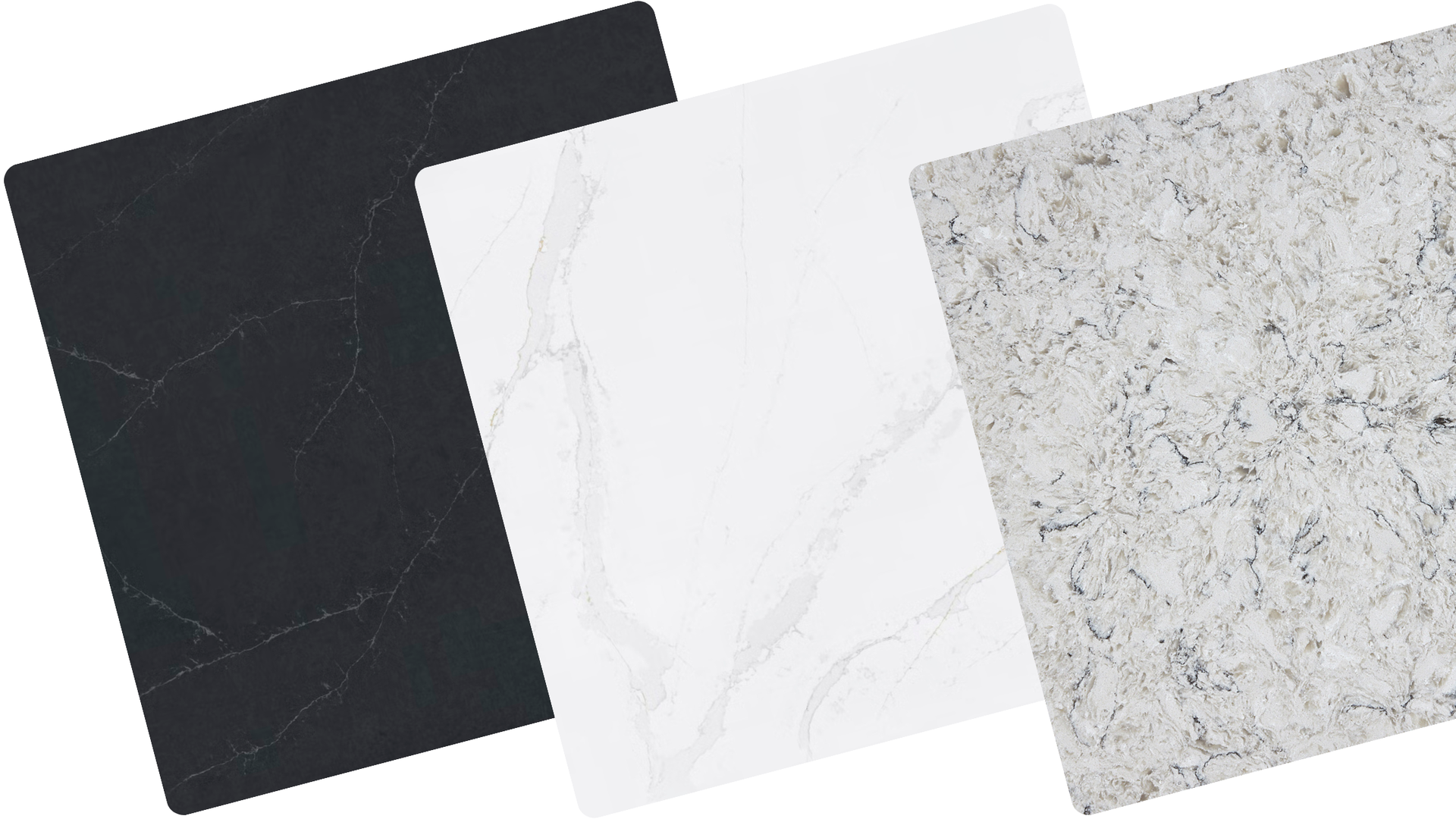
When homeowners begin exploring quartz countertops , one of the first questions that comes up is price. Quartz is an engineered material, and its cost can vary widely depending on how it’s made. From my perspective in the shop, the numbers always come back to three things: how much quartz is in the product, how much resin is in the product, and the quality of that resin. Add in the complexity of the pattern, and you’ll understand why one slab costs more than another. What Drives Quartz Pricing Quartz isn’t all the same. The differences in cost are tied directly to what goes into the slab and how it’s manufactured. Here are the main factors: Quartz content : Higher-end slabs contain a larger percentage of quartz and less filler material. Resin quality : Better resins resist discoloration and hold up longer against daily use. Quartz-to-resin ratio : A strong balance ensures the slab is durable and less prone to issues. Pattern complexity : Simple, uniform patterns cost less to produce. Distinct veining and bold designs drive up manufacturing costs. When you see a material with intricate veining that mimics natural stone, you can bet it took more effort and technology to create. That extra work is reflected in the price. Resin and Heat Sensitivity One thing that doesn’t change across the board is resin sensitivity. No matter what engineered stone you choose, resin reacts to heat. This is what we call thermal shock. Place a hot pan directly on the surface, and it can discolor or even crack. Higher-quality resins perform better, but all quartz materials contain resin and need a little care. That’s why we always recommend using trivets or hot pads. A little prevention goes a long way in keeping your counters looking like new. Price as a Quality Indicator Quartz is one of the most competitive products in the market. Manufacturers are constantly trying to produce it at the lowest cost possible. Because of that, price becomes a reliable indicator of quality. If you find a slab that’s significantly cheaper than the others, chances are it has more resin, less quartz, or a lower-grade resin that won’t hold up as well over time. From my experience, the service life of your countertop will almost always reflect the dollars you put into it. Spending more upfront means you’ll spend less time worrying about discoloration, wear, or needing an early replacement. The Value of Mid-Range vs. Premium Mid-range quartz is often uniform in color and pattern. It offers durability and a clean look, and it’s a good fit for homeowners who want function at a fair price. Premium quartz goes further. It offers richer quartz content, higher-quality resin, and patterns that look remarkably close to natural stone. The investment in premium often pays back in both aesthetics and longevity. Think of it like this: mid-range quartz will get the job done, but premium quartz is built to impress and last. When you’re remodeling a kitchen you plan to live in and enjoy for years, the extra dollars often make sense. My Recommendation If you’re shopping for quartz, spend as much as you can comfortably afford. You’ll get a better service life, a more beautiful finish, and fewer concerns about resin issues down the road. Quartz countertops aren’t just a purchase—they’re a foundation for your kitchen. The quality you choose will shape how they look and perform for decades. Come walk through our Prescott showroom, see the differences for yourself, and let’s find what makes you feel good. Designing Surfaces For Your Life
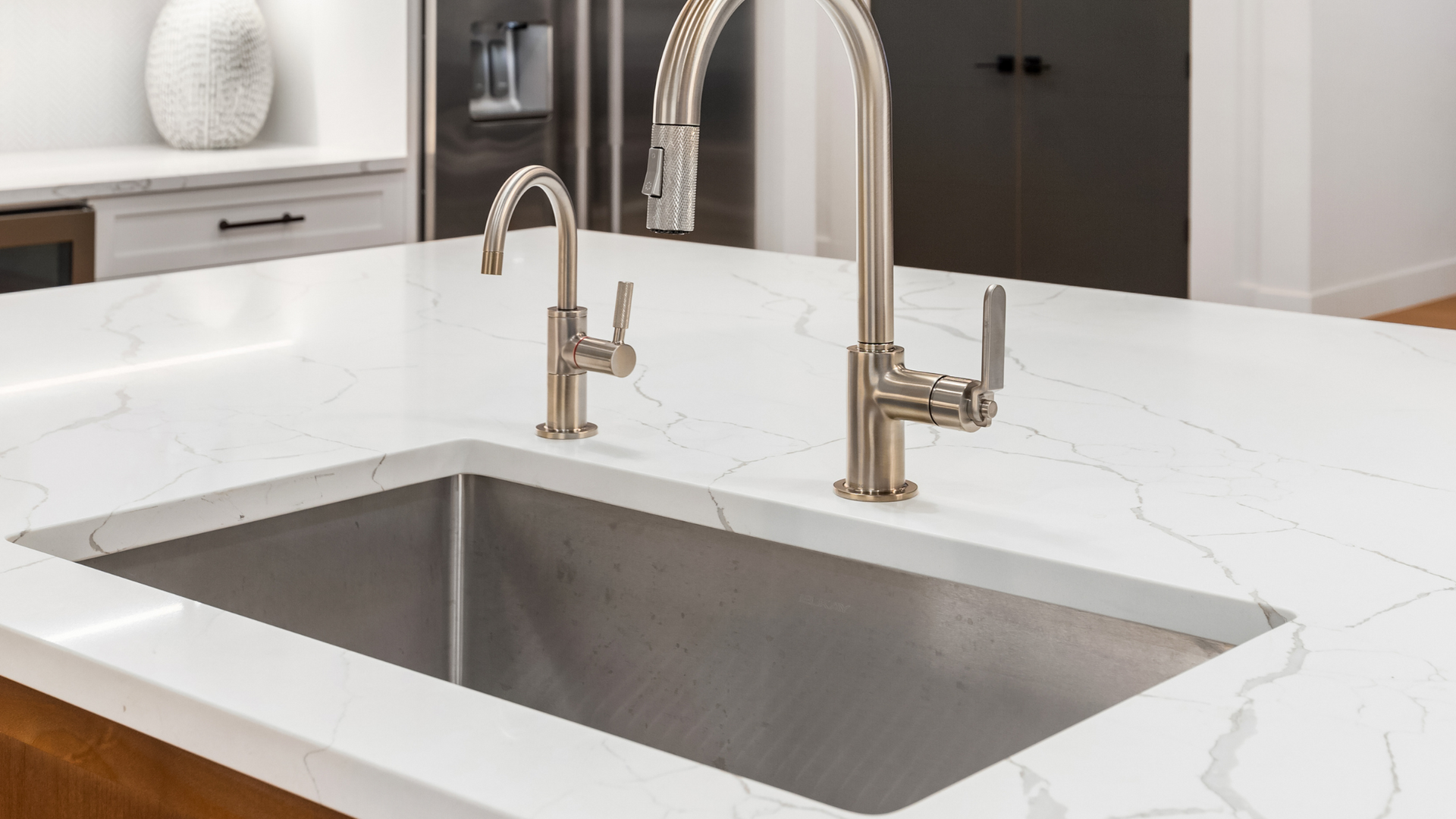
When you’re planning a new kitchen, the sink choice may not feel like the biggest decision on the list. Cabinets, countertops , and layouts usually take center stage. But the type of sink you choose, undermount or top mount, can have a big impact on both the installation process and the long-term durability of your countertops. After 27 years in the shop and out in the field, I can tell you there’s a clear winner. Why Top Mount Sinks Cause Trouble Believe it or not, we really dislike top mount sinks. They create more problems than most homeowners realize. The issue starts with the way the stone has to be cut. To drop a top mount sink into place, more stone must be removed, leaving thinner sections in front and behind the sink opening. For example, with a typical undermount sink, you’ll have: 3 ½ to 4 inches of stone in the front 3 ½ to 6 inches in the back That gives the countertop strength and stability. On top of that, we reinforce the sink cutout using a process called “rodding.” We flip the slab, cut small channels, and epoxy in fiberglass rods. This adds structure and helps keep fragile stone from breaking. With a top mount sink, you’re often left with only: 2 to 2 ½ inches of stone at the front 2 to 2 ½ inches in the back. That lack of material makes the whole section weaker and prone to cracking. In fact, I’d say at least one out of every two top mount kitchen sinks we’ve seen develops some kind of fracture over time. Cracks, Repairs, and Headaches Once a crack shows up, even a good repair will usually leave a visible mark. The countertop may still function, but nobody wants to see that line every time they walk into the kitchen. When homeowners invest in stone, they’re looking for beauty and durability, not hidden stress points. That’s why we do everything we can to steer people away from top mounts. Cost and Value Some people think a top mount sink will save money. From our perspective, there’s no difference. We don’t charge more for one type of cut versus the other because we pre-cut sink holes in the shop. Whether it’s an undermount or top mount, the labor is essentially the same. The only cost difference comes from the sink itself. Undermount sinks are often a little more expensive than top mounts, but the investment pays off with a cleaner installation, fewer issues, and a longer service life. Everyday Living: Cleanliness and Convenience Durability is the big factor, but the daily experience matters too. Undermount sinks make life easier. You can wipe crumbs or spills straight into the sink without catching debris on a rim. There’s no edge for water and grime to collect around, which keeps things more sanitary. Kitchens are meant to be used every day, and an undermount simply holds up better to that reality. Our Recommendation From the fabrication shop to the job site, we’ve seen what works and what doesn’t. Top mount sinks weaken stone and often lead to cracks. Undermount sinks stay stronger, look cleaner, and help your countertops last. There’s no savings in going with a top mount, but there’s a real risk of problems down the road. If you’re in the planning stage of your remodel or new build, give careful thought to your sink choice. An undermount will serve you better in the long run. Bring a sketch and come see us at our Prescott showroom . Let’s find what makes you feel good and build it into a kitchen that works for your life. Designing Surfaces For Your Life

Start with the Heart of the Kitchen In most homes, the kitchen island isn’t just a surface—it’s a centerpiece. It’s where conversations start, where the kids do homework, where friends gather while the meal is cooking. For a lot of people we work with, the island becomes the heartbeat of their kitchen. So it makes sense to give it some visual weight and design presence, something that makes people pause and say, wow. One way to do that is by giving the island countertop a little extra thickness. What Does “Extra Thickness” Actually Mean? Standard countertop material, especially premium natural stone like granite or quartz, typically comes in a 3cm (roughly 1¼") thickness. It’s strong, elegant, and doesn't require a sub-top like thinner materials do. But when a homeowner wants to make their island a real showpiece, we can create the illusion of a thicker slab, say, 6cm—by laminating the edge. That means we bond an extra piece of stone along the front edge to give it that substantial, double-thick look. From across the room, it reads bold, modern, and custom. It’s a simple upgrade that can make a big statement. Why Just the Island? Here’s the truth: the island is often where our clients fall in love—with a unique stone, a dramatic pattern, or a color that just sings to them. But covering every counter in the kitchen with that same material can get expensive, fast. That’s where design—and budget—strategy comes into play. A common approach we suggest is this: Choose your dream material for the island, and pair it with a more cost-effective, complementary surface on the perimeter countertops. It creates contrast, adds dimension, and lets you stretch your budget without compromising the vision. Here’s why it works: The island is usually the natural focal point in the kitchen layout. Guests often gather around it—it’s a social and visual hub. Thicker edges on the island add presence without overwhelming the whole kitchen. Pairing with simpler surfaces on the perimeter keeps the overall look balanced. We do this kind of split-design approach a lot, and it never feels like a compromise. If anything, it turns into a smarter, more curated outcome. Statement, Not Show-Off When someone walks into a kitchen and sees that extra-thick island top, it sends a message, but it’s not about showing off. It’s about confidence in your style. It’s about choosing a focal point that reflects you. And it’s about making intentional decisions that elevate the space without blowing the budget. There’s also a craftsmanship angle to all of this. Laminated edges require precision and care. Done right, they’re seamless. That’s something our team takes pride in, delivering polish and quality you can feel in every edge. Things to Consider Before Going Bold Extra thickness isn’t for every project. It involves more material, more fabrication time, and more cost. So before going that route, we usually help clients think through: Where’s the visual focus? If it’s the island, that’s a strong case. Does the kitchen layout support contrast? Separate colors and thicknesses work best with a thoughtful design flow. Is it in the budget? If not, there are other ways to create impact—unique edge profiles, waterfall sides, or just an incredible stone choice. You don’t need a thick edge everywhere. One bold move, on the island, can hit just the right note. Your Kitchen, Your Statement At the end of the day, the best kitchens reflect the people who live in them. If there’s a material that speaks to you, but the price tag on doing your whole kitchen in it feels out of reach, don't walk away from it—let’s find a way to feature it. Start with the island. Build your design around it. That’s how a statement becomes a story. Bring a sketch and come see us. Let’s find what makes you feel good. Designing Surfaces For Your Life
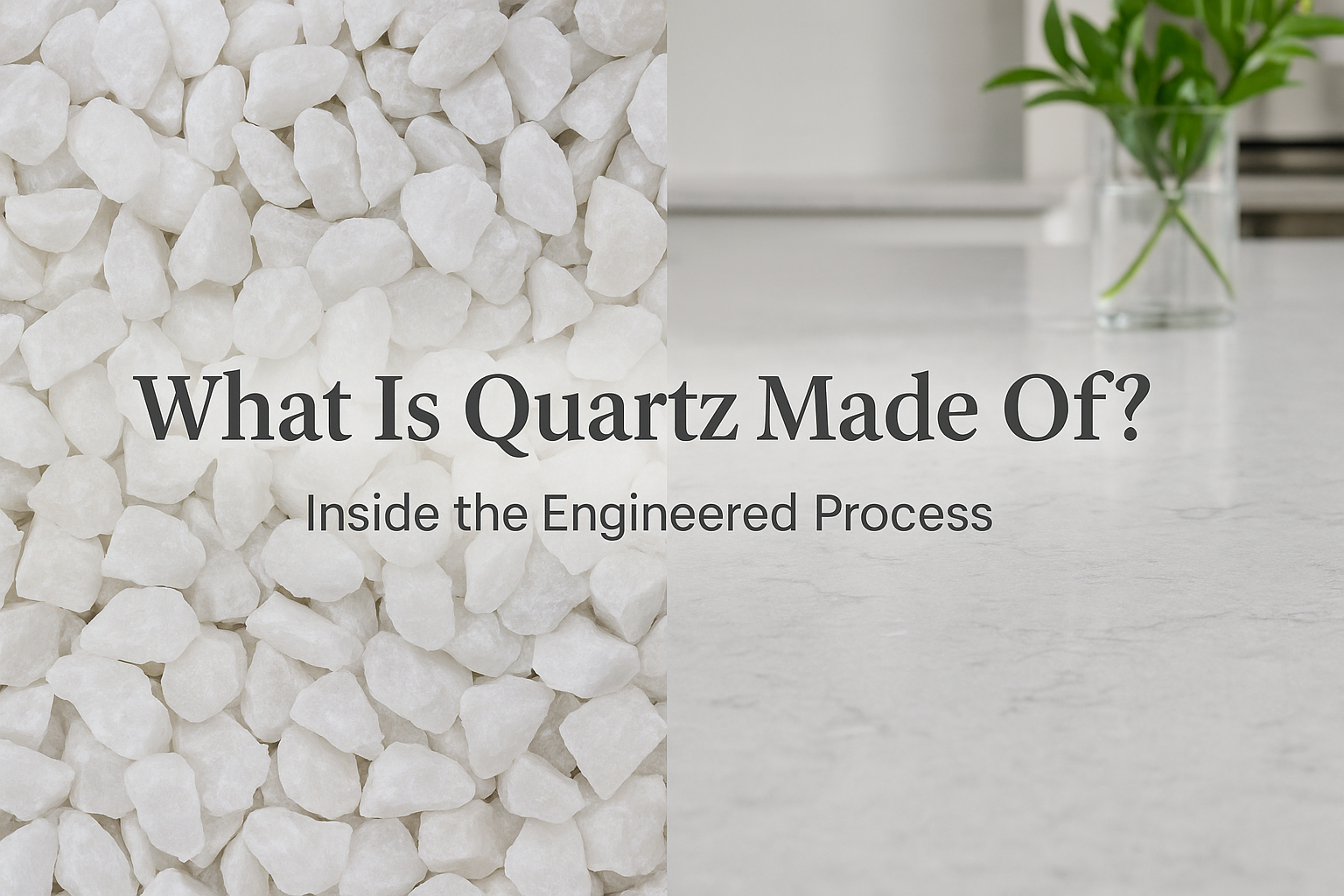
Engineered, But Not Artificial When people hear the word ‘engineered’ in the context of quartz countertops, they sometimes assume it means fake, or somehow less than natural stone. But here’s the truth: engineered quartz is built from one of the hardest, most durable minerals on Earth, natural quartz. It’s not a knockoff. It’s a purpose-built product designed to deliver strength, style, and consistency. We’ve worked with quartz for years now, and we’ve seen just how far the technology has come. If you’re curious about what exactly goes into these countertops, here’s a closer look—straight from the shop floor to your kitchen. So, What Is Quartz Made Of? Engineered quartz slabs are made from about 90–95% crushed natural quartz, blended with resins and pigments to create a solid, uniform surface. The result? A highly durable material that’s non-porous, low-maintenance, and available in just about any color or pattern you can imagine. Here’s a quick breakdown of the core ingredients: Natural Quartz: This is the base of the product. Pure quartz is typically white or translucent and incredibly hard—perfect for surfaces that see a lot of use. Pigments/Dyes: To get all those beautiful colors and patterns, manufacturers use colorants to tint the quartz. These can range from subtle creams and grays to deep blues, greens, and bold, marbled mixes. Resin Binders : These act like the glue that holds everything together. They also help create that smooth, sealed finish that makes quartz resistant to stains, moisture, and bacteria. The real magic happens in how these components come together. Inside the Manufacturing Process Every quartz manufacturer has their own twist on how they make their slabs, but the general steps are pretty similar across the board. Here’s a simplified look at the engineered process: Crushing & Mixing : Raw quartz is ground down into different sizes—some fine like sand, others more coarse for texture. It’s then blended with pigment and resin in large mixers. Molding & Compression : The mix is poured into molds and pressed using vibration and vacuum systems to eliminate air bubbles and make sure it’s completely compacted. Curing : The slab is baked at high temperatures to harden and set the resin. This turns the mixture into a dense, solid surface. Cutting & Polishing : Once cured, the slabs are trimmed to size and polished to create different finishes—from glossy to matte to leathered textures. Quality Control : Each slab is inspected for color consistency, structural integrity, and surface finish before heading out to fabricators like us. The slabs typically come in what we call jumbo sizes, around 65 inches by 130 inches. That gives us plenty of flexibility to design for kitchens, bathrooms, and other spaces without awkward seams or waste. Why Choose Quartz? Every material has its strengths. Quartz has become popular for a reason—it gives people the look they want with the performance they need. We see it chosen most often by homeowners who want: A consistent look across large surfaces Low maintenance (no sealing needed) Stain and scratch resistance Modern colors and marbling that mimic natural stone Durability that holds up over time And because quartz is engineered, you’ll find more pattern control and repeatability, something that’s tough to guarantee with natural stone. Designed with Intention Quartz isn’t a shortcut. It’s a smart material for people who want the look of stone without the unpredictability. It’s engineered, yes, but it’s engineered with intention, using one of nature’s strongest elements as its foundation. If you’ve been curious about quartz and whether it’s right for your project, come walk through our showroom. We’ll walk you through the options, show you some slabs in person, and help you decide what feels right. Bring a sketch and come see us. Let’s find what makes you feel good. Designing Surfaces For Your Life
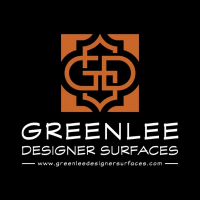
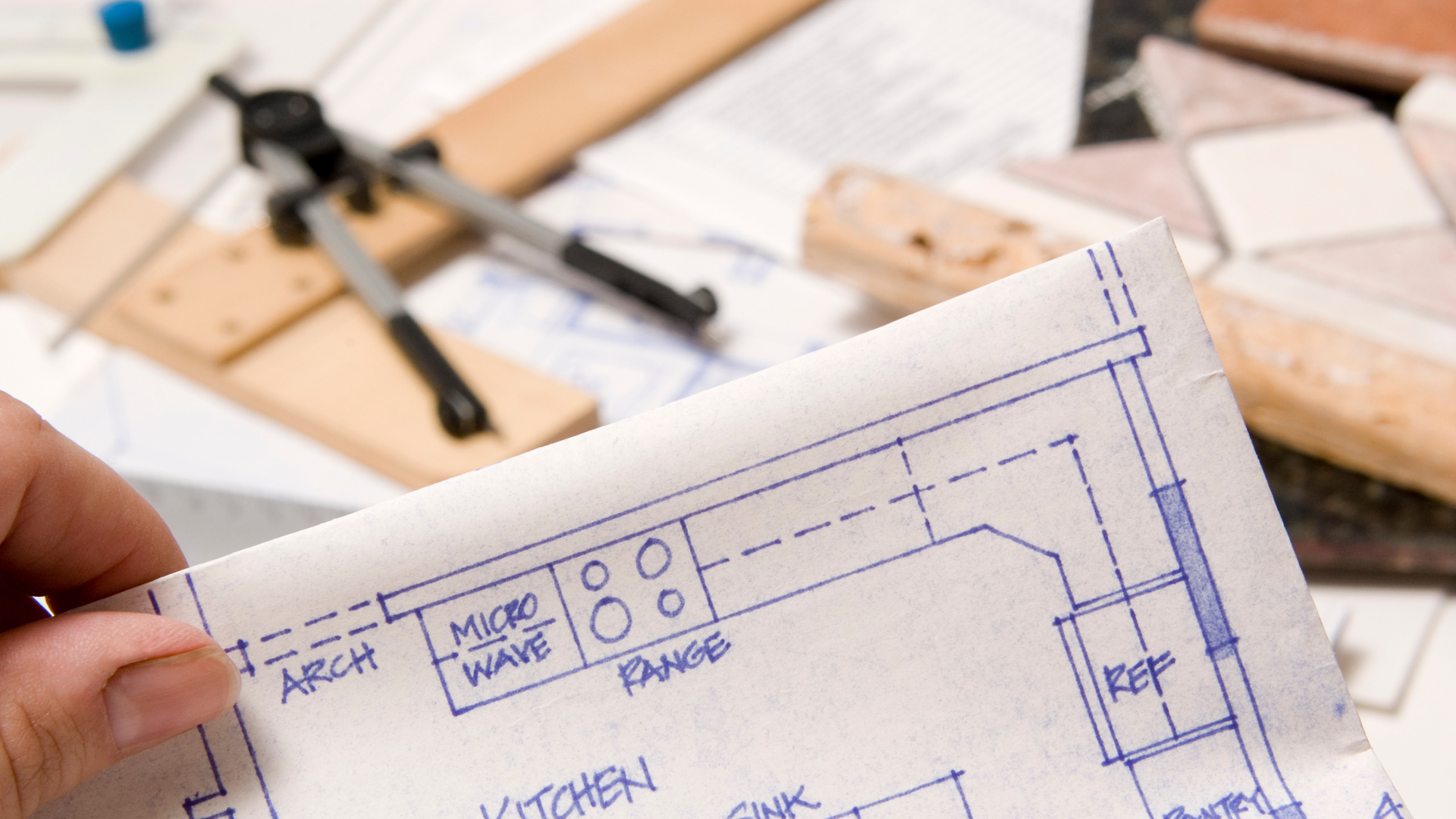
Share On: